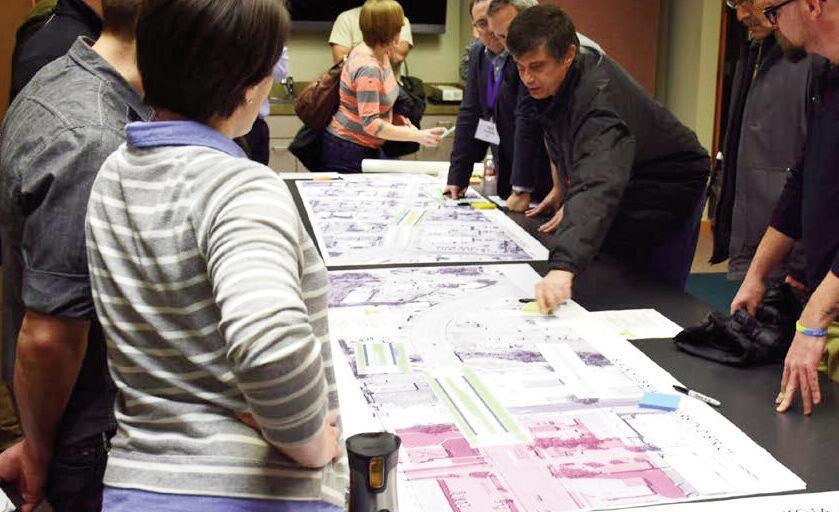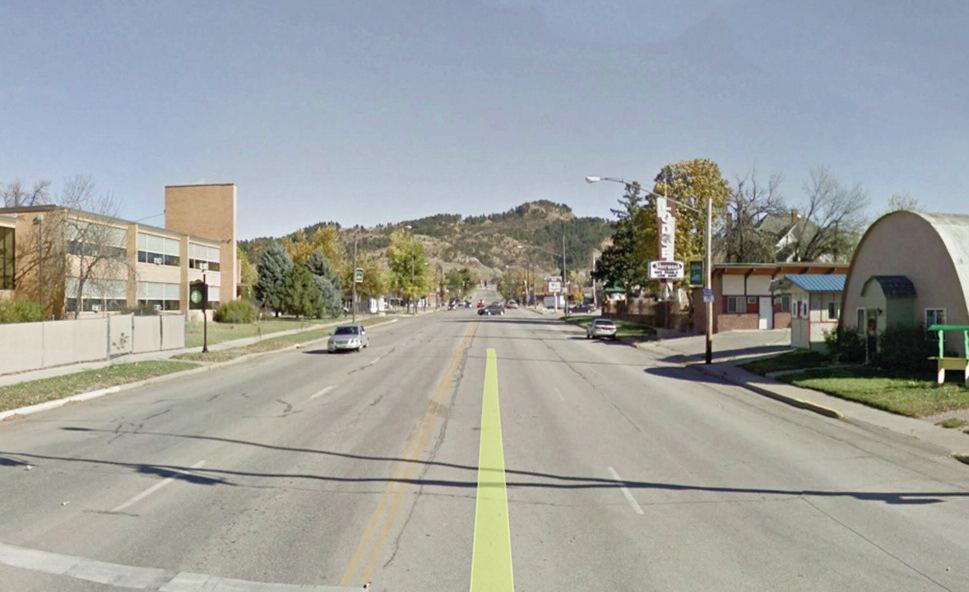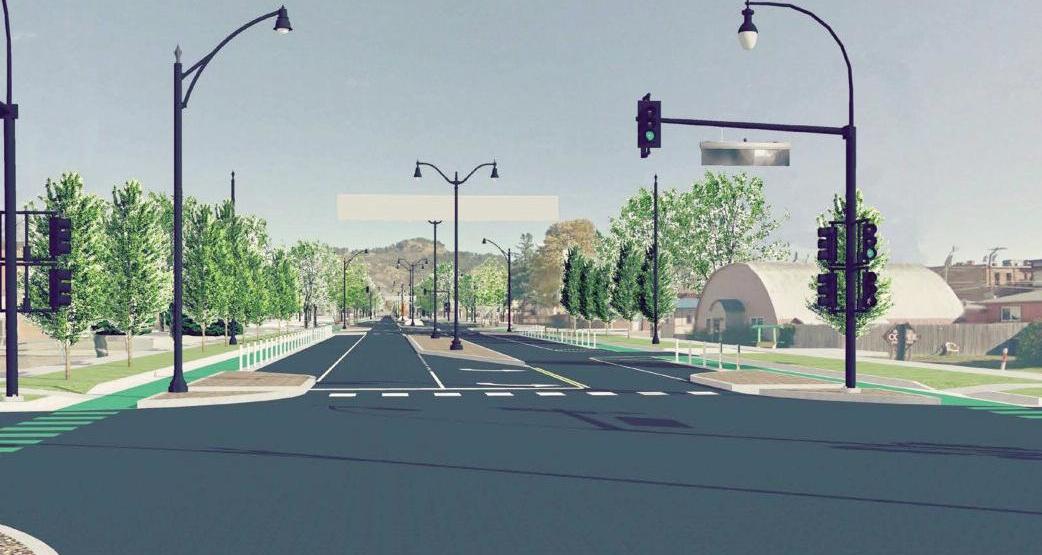
5 minute read
TheWinding Road of Change
The Winding Road of Change
By Jayna Watson, City Planner, Spearfish SD
Advertisement
At the 2017 Western Planner conference, Charles Marohn, founder of the advocacy group Strong Towns (www.strongtowns.org), reviewed the benefits of tackling large public works projects in smaller incremental steps. The core of Marohn’s message is that instead of pursuing multi-milliondollarinfrastructureinvestmentsthatresultin permanentandbigchanges,testoutthedesignthemesfirst inascaleddownversion.Thisapproachrecentlyplayedout inSpearfish,SouthDakotaasthecommunityspentthelast year discussing options for the renovation of a key street, Jackson Boulevard, beginning with an expansive (and expensive) new vision for the street, and ending up with something significantly different.
Jackson is the primary gateway into downtown Spearfish. Once the driver leaves Interstate 90, the view along this streetisframedbyquaintneighborhoodsonbothsidesand in the distance, Crow Peak invites the explorer to hike her trails to a breathtaking summit at just over one mile above sea level.
Jackson Boulevard Current Conditions
This major street has existed for over 125 years. The currentfour-laneconfigurationiswithina100footrightof way and has existed since the 1970s when the Interstate highway was built. Drainage issues, pavement and sidewalk deterioration, plus a host of the usual suspects of aging infrastructure prompted the city to begin planning foramajorupgradeofamilelongsectionofthisstreetthat originally was to take place in 2018.
Ourcitizensareacaringandinvolvedgroupofpeoplethat want to be part of major decisions and Jackson’s remodel was no exception. Knowing this, the city initiated a citizen-driven design process in February 2017 and an extensive public meeting campaign was started which included mailed postcards to the landowners along Jackson,aswellasinvitationspostedonthecity ’swebsite and social media. The first public meeting filled the City Council chambers with over 60 people as the design team represented by AE2S/Civi Engineering, Olsson and Associates/Traffic Engineering and Tallgrass/Landscape Architecture rolled out every idea possible for what could comprise a new vision for Jackson. The public was invited to write down theircommentsandattachthemtothevariousideaboards that included landscape medians, new bike lanes, wider sidewalks,updatedstreetlights,publicart,streetfurniture, and the like.

Residents use templates to discuss options Post-it notes covered the idea boards with some instances of one person writing down a comment and another who wrotesomethingcompletelyopposite.Peoplewereableto vote for ideas they liked using colored sticky dots. Street design templates were used like paper dolls as people experimented with different street layouts and configurations to see what they liked the best. From all of thisinput,thedesignteamwasthentaskedwithcombining hundreds of ideas and concepts into one cohesive vision. InMayof2017,theteamreturnedtotheCityCounciland presented their design proposal using illustrations of the before and after scenarios to depict the plan.

Before: Existing 4 lane Jackson Boulevard
The preliminary design vision included these main featuresthatarekeythemesoftheRoadDietphilosoph:1)
Reduction from 4 lanes to 2 through lanes with dedicated left/right turn lanes; 2) bike lanes both sides of the street; 3) landscaped medians; 4) curb extensions at crosswalks; and 5) a roundabout at one of the intersections. All these features along with the standard underground utility work pushed the preliminary price tag to $7 million plus.

Proposed “ after
” using a Road Diet design theme As the engineering team began to narrow down what wouldbeincludedintheconstructionplansandarriveata final budget, public opinion of the plan began to shift, significantly. Concerns over the roundabout, the reduction in driving lanes, the loss of curbside parking to bike lanes inthecommercialsectionofthestreet,andtheoverallcost emerged from citizens - some of whom were involved in the early 2017 conversations, and some who were entirely new to the project. In December 2017, a final public input session was held and another round of sticky notes and comments surfaced that did not reflect the same changes and street amenities as when the project first started in February. Like a page torn out of the Charles Marohn playbook,onecitizensuggestedatthemeetingthatthecity should just stripe Jackson Boulevard into the reduced lane designandseeifitworksbeforeinvestingsomuchmoney


Proposed roundabout at Jackson and Ames Avenue
into landscape medians. Finally, the City Council elected to retain the current four-lane configuration with the potential to add in some enhancements such as the upgraded crosswalks, and possibly the bike lanes. With only 100 feet of right of way to work with, as of this writing,itremainstobeseeniftherewillbeenoughspace tofittheseelementsinsincetheyarepartoftheRoadDiet design theme.
Lessons learned in this process:
Over time, opinions will change. Aswordgetsoutforwhat is being considered, there are many opportunities for information to be exchanged that may or may not be accurate. As planners, we cannot control this, but we do need to be aware of it. An incredible effort took place by the design team and city staff to continually illustrate, explain,andshowthepublicwhatwasplanned.Thecity ’s website contained a special link to the Jackson Street project complete with videos and other resources that communicated the design ideas.
Be aware of extraneous circumstances. As the design

discussion on Jackson was unfolding, a major downtown building project along Jackson Boulevard required the closure of one of the driving lanes at the intersection with Main Street and resulted in traffic back-ups.This scenario formed the assumption in many people’s mind for how Jackson was going to function with the reduced lanes. Here again, educate and inform when the opportunity presents itself.
Plan and deploy projects incrementally, whenever possible. Small but continuous change allows the public timetoacceptthe‘newthing’ .Afewyearsago,oneofthe traffic signals on Jackson was accidentally damaged at the intersection of Canyon Street, which caused the city to removeallthetrafficsignalsatthisparticularintersection, temporarily. For several months, drivers navigated around a stop sign that had been placed dead center at the intersection in somewhat of a mini-roundabout configuration. It wasn’t long before the flow of traffic around the stop sign became the new normal before the city installed the new replacement traffic signals,Another example of incremental change (although not the same scale and scope as the Jackson Boulevard project) is at Interstate 90’s Exit 14 in Spearfish, where a brand new single point urban interchange is nearly complete to replace the old diamond style interchange. Over the past 18 months, as the contractor completed and opened new lanes, drivers cautiously navigated the area with the assistance of signage and traffic cones directing travel. By the time the actual traffic control signals are installed this spring, the learning curve will nearly be over.
In summary, projects that involve major changes in local street design and long timelines to implement those changes always will be vulnerable to shifts in public acceptance. As planners, our job is always to focus on processtransparencyevenifitmeansthegreatideasdon’t get implemented, or even if only a part of the great ideas get done in an incremental fashion. All is not lost. The citizen who suggested that we try out Jackson Boulevard as a three-lane street with just painted lines is probably on to something because it would allow our community a chance to try before they buy, so to speak. Will Jackson Boulevard evolve from a four-lane standard roadway to a two-lane parkway?Time and public opinion will tell.











